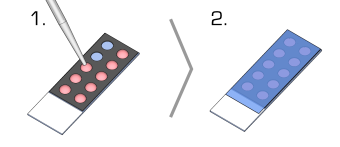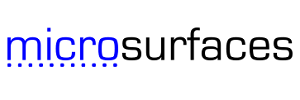
The microculture arrays contain circular hole arrays through a polymer membrane that can be used to create micro litre wells and are a perfect solution for dynamic live cell imaging and analysis, immunfluorescence assays or cell culture. The format enables the microculture arrays to be used with a variety of cell culture ware (polystyrene dishes, glass slides, coverslips) that contains biologically treated surfaces resulting in a micro-well with an active base and hydrophobic walls.
The size and shape of the microculture arrays are suitable for high, medium and low resolution imaging of cells depending on the thickness of the cell culture ware substrate.
The advantage
Compatible with an extensive range of culture ware
Suitable for fluorescence, transmission, DIC, FRET and FLIM imaging
No glue or adhesive required
No change to standard workflow
Increased data collection efficiency
Achieve long term live cell imaging
The microculture arrays are polymer arrays manufactured from a bio-compatible silicone polymer with circular through holes mounted onto a glass slide. The arrays can be used immediately with the glass slide or they can be removed and used with any suitable glass or polymer surface based cell culture ware or imaging chamber.
| Product code | Well diameter (mm) | Depth (mm) | Surface area (mm2) | Well shape | Wells per array | Arrays per pack | Price per pack (AUD$) | MOQ |
|---|---|---|---|---|---|---|---|---|
| MCA-01-01 | 15 | 1.25 | 176 | Circle | 1 | 10 | $200.00 | 1 |
| MCA-02-01 | 15 | 1.25 | 176 | Circle | 2 | 10 | $200.00 | 1 |
| MCA-03-01 | 12 | 1.25 | 113 | Circle | 3 | 10 | $200.00 | 1 |
| MCA-10-01 | 7 | 1.25 | 38 | Circle | 10 | 10 | $200.00 | 1 |
| MCA-40-01 | 3 | 1.25 | 7 | Circle | 40 | 10 | $200.00 | 1 |
| MCA-CS-60x24 | N/A | N/A | N/A | N/A | N/A | 20 | $10.00 | 1 |
Product specifications published on the website may be subject to change without notice.
If you cant find what you are looking for then please have a look at our Custom products page as we offer custom manufacture, or alternatively email us at sales@microsurfaces.com.au to discuss your requirements.
The product code refers to the packaged product which contains 1, 2, 3, 4 or 10 individual arrays. All prices shown are in AUD$ and do not include GST (for Australian orders) or VAT (for European orders). For Australian orders the GST will be confirmed during quotation/ordering and for European orders VAT is payable by the customer. Pricing in Euros and US$ can be provided. Prices do not include postage. All international orders will be shipped by Fedex and freight costs will be confirmed during ordering.
MOQ = Minimum Order Quantity.
The microculture arrays are mounted on a German glass slide with a frosted end. No. 1 German coverglass (60 x 24mm), MCA-CS-60x24, can be ordered separately that can be used as the substrate for mounting the microculture arrays and/or for sealing the arrays.
The microculture arrays are sterilsed in alcohol prior to shipping. Prior to use (or re-use) they may be sterilized in alcohol, UV or by autoclaving.
Technical drawings of the arrays with dimensions are shown below.

Dynamic live cell imaging and analysis
Immunofluorescence assays
High content imaging and analysis
Single cell imaging
In-situ hydridization
Cell tracking
Imaging cell-cell interactions
Cell culture
User guides
Instructions for using microculture arrays - immunofluorescence assay

1. Place the microculture array into a 100mm culture dish and pipette the cell suspension directly into the isolated wells in the removable silicone array. NOTE: the array could also be removed from the glass slide and placed directly onto the surface of the culture dish, coverslip or other cell culture ware.
1 well - 250μL
2 well - 250μL
3 well - 200μL
10 well - 50μL
40 well - 8μL
2. Cover the culture dish with a lid to reduce evaporation and incubate the cells following standard procedures.
3. Remove the silicone array by gently lifting a corner with tweezers and peeling the array off the glass slide. NOTE: this step can be performed after fixing/staining.
4. Perform standard staining protocols on the slide (fixation, permeabilization, staining, washing).
5. Seal a coverslip (60 x 24mm) onto the glass slide with your choice of mounting medium.
NOTE: Typical well volume for pipetting cell suspension for cultivation.
Instructions for using microculture arrays - live cell imaging

1. Place the microculture array into a 100mm culture dish and pipette the cell suspension directly into the isolated wells in the removable silicone array. NOTE: the array could also be removed from the glass slide and placed directly onto the surface of the culture dish, coverslip or other cell culture ware.
1 well - 100μL
2 well - 100μL
3 well - 70μL
10 well - 20μL
40 well - 4μL
2. Seal the array with a coverslip (60 x 24mm) by gently pressing the coverslip down onto the array.
NOTE: Typical well volume for pipetting cell suspension for live cell imaging. Smaller medium volumes are required to prevent cross contamination when the array is sealed. The smaller liquid volume may not completely fill the well prior to sealing.
Do the microculture arrays require adhesive?
No, the arrays are self-adhesive and will stick to polymer or glass surfaces.
Are the microculture arrays re-usable?
While it is possible to re-use the arrays we strongly discourage re-using the arrays. Small molecules and proteins can adsorb onto the polymer surface which can affect subsequent experiments.
Can cells move between the wells in the microculture arrays?
Under normal conditions cells are not able to migrate between the wells.
Is it possible to perform independent experiments in the wells in a microculture array?
It is possible to perform independent experiments in individual wells by placing a lid on the top of the array to seal the individual wells. Once the cells have been introduced into the wells a glass coverslip can be used to seal the array. Gently press the coverslip onto the array using your finger to ensure that it is sealed against the array.
Which solvents and chemicals are compatible with the microculture arrays?
Below is a list of solvents and their compatibility with the microculture arrays. Please note that solvents with a high swelling ratio will likely cause the array to swell and detach from the surface of the imaging chamber.
| Solvent | Compatible | Swelling ratio |
|---|---|---|
| Acetone | Yes | 1.06 |
| Acetonitrile | Yes | 1.01 |
| Chloroform | Yes | 1.39 |
| Dimethyl sulfoxide (DMSO) | Yes | 1.00 |
| Ethanol | Yes | 1.04 |
| Hexane | Yes | 1.35 |
| Iso-propanol | Yes | 1.09 |
| Methanol | Yes | 1.02 |
| Water | Yes | 1.00 |
What material are the microculture arrays made from?
The microculture arrays are manufactured in polydimethylsiloxane (PDMS), Sylgard 170 from Dow.
Is polydimethylsiloxane (PDMS) biocompatible?
Polydimethylsiloxane (PDMS) has been demonstrated to be a biocompatible polymer for use in imaging and culturing many types of mammmalian cells. It is one of the most common materials used in the production of microfluidic devices.
Can the microculture arrays be used with a high magnifaction objective?
For imaging experiments with an objective lens with a magnifcation of >60x then the microculture arrays will need to be used with a coverslip. This can be achieved by sealing the array with a coverslip or removing the array from the glass slide and mounting onto a coverslip (60 x 24mm coverslip recommended). Once mounted on a coverslip the array can also be sealed with a second coverslip.
What products can the microculture arrays be used with?
The microculture arrays can be used as they are with the glass slide provided, coverslips (60 x 24mm coverlips recommended) or with any standard cell culture ware dish with polymer or glass surfaces.
Do the microculture arrays produce fluorescence?
Under normal fluorescence microscopy conditions there will not be any fluorescence detected from the microculture arrays. When imaging cell autofluorescence the higher laser power has been shown to generate very minimal autofluorescence.
What is the shelf life of the microculture arrays?
The shelf life of the microculture arrays is 6 months. While the polymer used to manufacture the arrays does not degrade over time the self-adhesive ability of the array does reduce. It is possible to still use the arrays after 12 months assuming they are stored appropriately. If you are experiencing issues with the arrays not sticking to a surface have a look at the information listed under 'Tips & tricks' on the Instructions page.
How should the microculture arrays be stored?
The microculture arrays are shipped in a plastic container inside a vacuum sealed bag. Any unused arrays should be kept in the plastic container and vacuum bag (not under vacuum). The arrays can be stored at room temperature.
Please contact your local distributor or contact us directly at sales@microsurfaces.com.au to discuss your application and requirements.




